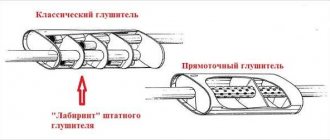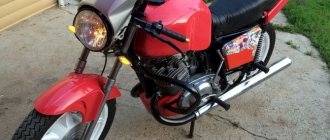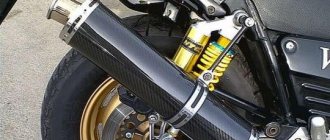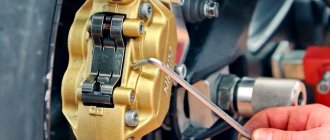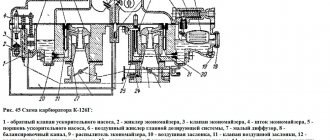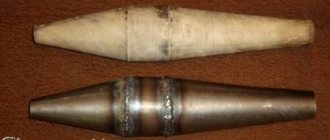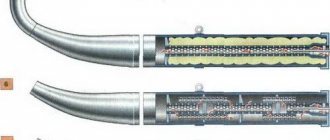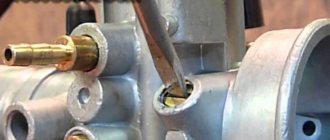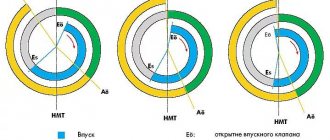The purpose of a muffler on a four-stroke scooter is to remove exhaust gases as quickly as possible with minimal noise. Therefore, tuning a muffler on a four-stroke bike is not at all a difficult task. Although, in both cases, it is necessary to change the pipes. In the case of a four-stroke engine, this is not so important in terms of which one to buy and whether anything needs to be configured. Everything is simple there.
But muffler for two-stroke engines are much more complex in production, settings and selection for each specific model for specific tasks.
The principle of operation of the exhaust system for two-stroke bikes is known and was discussed in the section “Scooter design”. It is known that part of the power is returned to the engine from the exhaust system during operation at certain speeds. If this whole process is implemented ideally, after tuning the muffler the scooter will be unrecognizable. Naturally, if other components were tuned before. After a general boost of the scooter, the stock muffler is not enough for adequate engine operation throughout the entire speed range and replacing the muffler with a tuning one is perhaps the only way to make your scooter run faster and more dynamically.
Exhaust systems of two-stroke engines
EXHAUST SYSTEMS OF TWO-STROKE ENGINES
The article was published in MOTO magazine March 1996.
You often hear talk among motorcyclists about the role of the muffler: some say that if you remove it, the engine will trample “like a beast,” others say the opposite. But most often, debaters do not specify what type of engine they are talking about - a two-stroke or a four-stroke. And the difference is fundamental. After all, if it is a four-stroke, then the presence or absence of a muffler will not greatly affect the power, but on a two-stroke it is the opposite - the operation of the engine can change so much depending on the presence or absence of a muffler that you are amazed.
We asked the famous amateur designer Alexey Garagashyan to share his experience in designing and tuning exhaust systems on numerous motorcycles of his own design.
The exhaust systems of two-stroke engines are very diverse, and before we begin to give any practical recommendations, we will try to classify them. We can count at least six well-known options. Let's start with the simplest.
The most common system today is a system consisting of a resonator (power part) and a muffler (muffling part). We will talk about what is needed for what later, but now we will continue the classification. Sports motorcycles twenty to thirty years ago used exhaust systems consisting of a single resonator.
Courageous racers and their fans agreed to endure the roar of engines, because the muffling part takes away part of the power. But not so long ago, standards were introduced to limit noise for racing motorcycles. Accordingly, such solutions are no longer applied.
On motorcycles you can also see exhaust systems with only one muffling part going after the exhaust pipe. This is exactly how Kovrovsky prepared them for the Altai Around the World. Looking ahead, we can say that they had fairly high fuel consumption, poor dynamics, but excellent traction at low and medium speeds.
You can often find motorcycles with only one exhaust pipe, without any changes in the cross-section inside. Most often, this is done either by the most ignorant owners, or by those who want to increase cross-country ability at any cost.
But the most advanced one today is the exhaust system, consisting of a power damper that regulates the height of the exhaust windows depending on engine speed or load, and a resonator and muffler following it.
Now let's talk about everything in order.
Numerous studies of the operation of two-stroke internal combustion engines show that with an untuned exhaust system or without it at all, the engine loses a significant part of the fuel-air mixture through the exhaust ports, from which, in fact, the exhaust system begins. The power and speed of the motor largely depend on their shape and size.
The angular width of the exhaust port is limited by the risk of damage to the piston rings, and according to research data should not exceed 65° for production engines and 70° for sports engines. If you need to enlarge them, make two or three windows separated by lintels. The height of the exhaust ports has a significant impact on engine power. An increase in height leads to rapid cleaning of the cylinder from exhaust gases, which contributes to an increase in speed, but at the same time, the proportion of lost stroke increases, since after opening the exhaust windows, the gases no longer exert pressure on the piston. This leads to a reduction in torque in the low and medium speed range. Power dampers help to get rid of such undesirable phenomena, they limit the height of the exhaust windows at low and medium speeds and open them completely at high speeds. By the way, power dampers have now become almost a mandatory part of a decent two-stroke engine.
Unfortunately, it is extremely difficult to manufacture such an effective device in our conditions, so we will not dwell on it for long, but will continue to get acquainted with the exhaust system. After the exhaust windows, as a rule, a resonator, or power part, scientifically speaking, is installed. Its main task is to prevent the release of fresh mixture. Choosing the optimal resonator parameters is quite complicated, but I will try to clarify this issue.
For a favorable gas exchange process, it is necessary that a low vacuum be created at the exhaust window in the first half of the purge phase, which helps clean the cylinder of exhaust gases. By the time the purge mixture approaches the outlet window, the pressure in the exhaust system (at the window) must increase and be maintained in this state until it closes. This pressure wave creates a reverse movement into the cylinder of part of the purge mixture that entered the exhaust system during purge.
If there is an unfavorable change in pressure, “clogging” of the exhaust system may occur, impairing cleaning and filling of the cylinder. A significant vacuum in the exhaust system at the end of purge facilitates the unimpeded ejection of the combustible mixture through the exhaust window.
The exhaust system is usually configured for one operating mode. It comes down to selecting the geometric dimensions of the resonator shown in Figure 2.
In most cases, these optimal RPMs are between medium and high. On motorcycles with a well-tuned exhaust system, a sharp pickup is often noticed when reaching a certain speed. It is often accompanied by such acceleration that an unlucky experimenter, not accustomed to such surprises, may have the opportunity to see a motorcycle moving away from him on its rear wheel, which is no longer possible to catch up with.
Those who like this type of engine can be advised to try adjusting the exhaust system of their motorcycle using some of the dependencies and dimensional ratios given below according to the drawing.
F0.vyp - cross-sectional area of the exhaust windows;
F1 is the cross-sectional area of the exhaust pipe.
As L1 increases, the torque curve shifts towards low speeds, and as L1 decreases, it shifts towards high frequencies. Optimal length L1=(5…6) D1
Angle α
opening of the first cone is taken from the condition of ensuring continuous passage of the gas flow
α
=6. 10°.
The length of the conical part L2 is determined by the angle α
and diameter D2, which is taken from the relation D2=
√
4F2/
π
,
By changing the length L3 of the cylindrical part and the position of the reverse cone, you can shift the engine characteristic in the required direction. By choosing the length L3 you can increase the maximum effective power in a certain diameter.
speed range due to cylinder recharging. However, at other frequencies the performance deteriorates,
As the length of the L3 increases, the maximum power decreases, but its values increase significantly in the mid-speed range.
The length L4 of the reverse cone affects engine performance as follows. If the cone of the L4 section is small (long L4 length), then the engine power decreases slowly at speeds above the rated speed. If the L4 length is short, the power drops quickly. Recommended length L4 =(1. 2.5)D1
The end section of the pipe, length L5, also has some effect on engine performance. As L5 grows and the diameter decreases, the maximum engine power shifts to the region of high speeds. Reducing the length of L5 helps to increase power at low speeds. Reducing the diameter of D3 causes overheating of the piston crown.
The muffling part of the exhaust system does not have a positive effect on power, but has a beneficial effect on the condition of the hearing organs.
The huge cigar-shaped mufflers of domestic motorcycles include both a power and a muffling part, and the exhaust pipe is a separate element. Often it enters the straight cone so deeply that the continuous flow of gases is disrupted. In this case, the ideal option would be to abandon the connection between the pipe and the cone using a union nut or clamp in favor of welding. At the very least, the part protruding inside the cone should be shortened.
Here lies the easiest way to partially configure the exhaust system. You can move the muffler forward by shortening the exhaust pipe. In this case, you should expect improved engine performance at high speeds, or vice versa, to obtain greater torque at low speeds, move the muffler further away and lengthen the first pipe.
Chinese scooter repair: engine
A working mechanism, including any engine, produces noise of varying degrees of volume. A change or increase in the noise level indicates wear of one of the parts inside the structure. All parts have a service life and, depending on the mileage, the quality of gasoline or lubricants, sooner or later they become unusable. If the owner listens to the running engine during idle, acceleration and at maximum speed, he will remember the correct noise, and will immediately recognize if foreign elements are added to it. If there is no experience, when starting to repair a scooter in China with your own hands, a phonendoscope is used to determine the cause of the malfunction. Let's consider the nature of extraneous noise, the reason for its appearance and the place where the part was worn out:
- A knocking sound is heard in the engine when fuel detonates. When the fuel detonates as it burns, this is expressed by the occurrence of a metallic knock due to the heavy load on the cylinder parts. They occur when using low-quality fuel or gasoline with a low octane number, in case of heavy accumulation of carbon deposits inside the combustion chamber and when the engine overheats. It is necessary to carry out diagnostics using available methods, reduce the engine load and replace the fuel with another one with a higher octane number. If the knocking continues, clean the combustion chamber or replace the spark plug. Do not operate the scooter with signs of detonation, this will lead to increased wear and malfunction of the loaded parts.
- The howl of worn main crankshaft bearings. It is difficult to confuse with other noise; the howling appears when you add gas and increases the volume as you continue to use the scooter. If the bearing is not replaced promptly, the balls will spill out of the main part and, mixed with the broken race, enter the crankcase, causing serious damage. Negligence in operation leads to serious damage and the need to carry out expensive repairs of Chinese scooters at a service center.
- Piston pin knock. The knocking sound is heard when the engine warms up at idle speed, and becomes noticeably louder if you turn the throttle sharply. Appears when the surface of the piston pin is worn out, the size of the piston boss holes is increased and the bushing located in the upper part of the connecting rod is worn out. A specialist in the workshop will restore the Chinese scooter (engine repair, identification and replacement of worn parts) as quickly as possible.
The reason why the scooter does not pull up or accelerates poorly may be a decrease in compression. This problem occurs due to:
- Active operation of equipment at maximum capacity.
- Wear of cylinder rings.
- Incorrectly selected parts.
- Error when boring the cylinder.
You can check the compression using a compression gauge. Ideally, the pressure should be 10 bar, but 7-8 bar is also good. If the readings are lower, then you need to lubricate the assembly, replace the ring and make sure that all parts are in good condition.
Resonant muffler: improving the efficiency of a two-stroke engine
Unlike four-stroke engines, two-stroke model engines (and not only) are distinguished by their low weight and size, as well as simplicity of design. Their only drawback - low efficiency - can be eliminated with the help of resonant mufflers.
Resonant mufflers appeared in the 50s of the last century. Their main purpose is to efficiently remove exhaust gases from the cylinder and improve the filling of the cylinder with a fresh mixture of fuel and air. As a result, the model engine begins to produce stronger torque and its efficiency increases.
If the resonant muffler is configured correctly, it can almost double the power of a model internal combustion engine. At the same time, the engine will operate in economical mode, which is good news.
Mechanical
The most radical, at the same time the most labor-intensive method that gives the best result is cutting and removing carbon deposits with various scrapers and tools, and subsequent sealing by welding. In this case, you need to know the internal structure of the system. Usually, a rectangular window is cut out on the side, through which work is carried out. After the muffler is welded, it will have to be painted to restore its aesthetic appearance.
It is easier to remove carbon deposits using a cable. You need to take a piece of cable of the required length, clamp one end into the chuck of an electric drill, fluff the other, and gradually move it inward, turning the cable with a drill at low speed. In some cases, they get a positive result.
In large rooms, due to reverberation, the sound can be very distorted. To prevent this phenomenon, constructive architectural solutions are used:
- false ceilings and cladding made of sound-absorbing panels are installed;
- A scattering and absorbing relief and resonator cavities are formed on the walls and ceiling.
How to select and configure a resonant muffler
At first glance, it is enough to simply screw the muffler to the model’s engine and its power will increase. But in reality it's not that simple. The performance of the muffler is influenced by the volume of the engine and the muffler itself, the diameter and length of the connecting pipe, the structure of the resonator and many other factors.
As a rule, all this is taken into account by ICE manufacturers already at the design stage of a resonant muffler.
Cleaning the muffler
The cleanliness of the muffler affects the power of the moped
Before you start changing anything in the exhaust system, I would like to give one piece of advice. The power of the scooter is directly affected by the cleanliness of the muffler. If it were possible to see the exhaust in a cross-section of the muffler, the owner of the scooter would be very surprised. After a certain mileage, the scooter's dynamics decrease, and owners begin to look for the reasons for this, finding them in a complete rework of the standard muffler or its replacement.
The reason for the loss of power, meanwhile, may be hidden in the condition of the engine itself. This will help determine the specialist you should contact before tuning. But the most common cause of loss of dynamics is soot that clogs the muffler. In this case, it is recommended to carry out cleaning in three ways.
First method: mechanical
It involves cleaning the muffler section (it is done with a grinder). The inside of the muffler is cleaned of soot using a wire or cable. The section in the section is closed by welding.
How to achieve maximum torque
It is best to tune a model engine to achieve maximum torque on a flat, paved area. Having prepared a sports stopwatch, it is necessary to measure and mark with chalk a distance of approximately 15 m. The engine must be well warmed up for the purity of the experiment and the accuracy of the measurements. The results must be taken into account arithmetic averages - after several races. Having shortened the pipe by about 2-3 mm, it is necessary to repeat the measurements.
Before shortening the pipe, you need to remove the muffler from the engine, separate the pipe by removing the silicone connecting tube. You can shorten the pipe in different ways - for example, using a regular hacksaw for metal. Burrs formed during sawing must also be removed from the end with a file or a sharp knife. If this is not done, chips may end up in the cylinder and this can be very bad for your engine.
After assembling the model, it is necessary to take repeated measurements. If the acceleration time takes a little less, everything goes as it should. You still need to shorten the pipe by about 2-3 mm and repeat the experiment. These operations must be repeated until shortening causes a deterioration in the result. In this case, you just need to pull the muffler about 3 mm further out of the silicone tube and secure it with a tie. Your resonant muffler is tuned!
Source
Is it possible to avoid a fine?
It is not a fact that you will be able to avoid punishment, but you can try. First of all, the motorist must assume a guilty look and ask for the minimum penalty provided for by law (Articles 12.5 and 8.23 of the Administrative Code) - a warning. You can assure the inspector that the cause of the violation will be immediately eliminated, and the problem itself arose quite recently. It will be a plus if, when checking the fines, it turns out that the driver is not registered with them.
If the representative of the State Traffic Inspectorate is not influenced by any convictions, you can simply agree to the fine and pay it on time - then only 250 rubles will be collected from the driver in favor of the state.
Resonant muffler: improving the efficiency of a two-stroke engine
A motorcycle muffler is a device that weakens the sound of the engine. Mufflers are needed not so much to reduce noise as to change the timbre. And high-frequency sounds have a more unpleasant effect on the human psyche and ear than low tones.
Many people associate the roar of sports motorcycles with a muffler. And they believe that filling the muffler can reduce the power of the car. But that's not true. When replacing or modifying a muffler, only a small amount of horsepower is lost.
There is an intake and exhaust silencer. And scientific research has proven that if you choose the right basic elements, you can improve the filling of the cylinder. Such mufflers are called resonant mufflers.
Noise suppression is carried out by the part of the muffler located behind the first partition, and it consists of an acoustic filter. These filters on sports motorcycles are made simpler, since a higher noise level is allowed in sports motorcycles.
When deciding to remake a muffler, you need to remember the following. Sometimes, when improving one part, you have to sacrifice the quality of another. No one has yet succeeded in creating a universal motorcycle.
Manufacturers recommend using factory mufflers for your motorcycle. The muffler cavity becomes covered with carbon deposits, which can close the acoustic filter channels. Therefore, the cavity of the device must be cleaned regularly. The resulting carbon deposits prevent the exhaust gases from escaping, and engine power is reduced. After every five to ten thousand kilometers, mufflers need to be cleaned.
The original mufflers are quite quiet and good. Their disadvantage can be considered their heavy weight and size. Many consider their high price to be a disadvantage. Silencers are produced by many companies, and you can use a non-original muffler if you wish. Most often these are open mufflers. In them, exhaust gases exit the engine without any obstacles. But they make a lot of noise.
Those who love the loud roar of motorcycles can buy the cheapest muffler, which does not muffle anything. But if the roar of the motorcycle does not suit you, then you will have to buy an expensive option.
These mufflers differ in design and material of manufacture. There are four types:
Each type of muffler has its own advantages and disadvantages. Therefore, you need to choose for yourself.
You can buy a direct-flow muffler in any specialized stores. They are usually of interest to young motorcyclists who dream of high speeds. But real bikers are not sold on stickers from famous brands. They do everything they need with their own hands.
If you want to enter the world for real men, you need to make a direct-flow muffler with your own hands. When riding at normal speed, its noise will not be different from other motorcycles. But as the speed increases, the characteristic rumble of the engine appears. What do I need to do?
Muffler conversion
As a rule, many craftsmen not only assemble a muffler, but remake a standard one. This makes it possible to spend less time and get a more acceptable option.
Tools and materials
Before you start tuning, you need to prepare the necessary tools. In this case, the following components will be needed:
Let's start tuning
First we dismantle the muffler. Then we take a grinder and cut out a piece of metal on top of the muffler. With this cut it will be much easier to work with the muffler. You should almost completely cut out the top part. After this, it is necessary to clean the entire internal space of the muffler, dismantling the cut-away elements.
It's time to work with the piece of pipe that we have prepared. Using a powerful drill or welding, we make many holes in the pipe. We place the pipe in the section of the standard muffler. We select in advance a pipe of such a diameter that it fits inside the standard one. It is desirable that the pipe be without any obvious flaws and perfectly straight.
Straight-through muffler in the process of assembly
The space in the cut that remains between the two pipes must be filled with metal pipe cleaners or similar materials. We weld the top of the pipe as it was. We reinstall all structural elements that were dismantled during the process.
As a result of the tuning, we will get a forward flow muffler that provides the desired result. The massive and rich roar of the engine, as well as the increase in power of the moped, will be evidence that everything was successful.
Stage 2.
The most labor-intensive and dirty process is disassembling the muffler.
My scooter has a stamped, non-separable muffler, probably everyone has one. All the seams were welded, and I had a vague idea of what was inside. I knew that there were several partitions and tubes.
I decided that I would take it apart from the end. To cut the muffler, you can use a grinder. But I thought that the mark from the disk would be too wide, and it wouldn’t be possible to “cut” evenly anyway. Therefore, I took up the old-fashioned method - a hacksaw for metal.
To prevent the canvas from overheating too much, I lubricated it with machine oil - I always do this, although I don’t know if it’s right? I sawed the jar in a circle so as not to touch the central tube - 5 minutes and done!
I sawed it off, and what I see is a partition and tubes.
After poking around a little, I realized: nope, he won’t figure it out that easily.
Maybe try to disassemble from the other end? But there are ears for fastening. No problem, the grinder will help. By the way, don’t forget about glasses - they will protect your eyes from debris and flying sparks. I cut it down. Now I use a hacksaw again to cut the can in a circle. I sawed it, but something is still holding it - I need to saw off the central tube. The can is open on both sides, but it doesn’t want to open it.
After cleaning the muffler from dirt on the body, I notice three welding points - the fastening of the central partition. You'll have to drill it out.
First we drill with a thin drill with a diameter of 2-3mm, and then with a larger one. I needed 8 mm.
Does the inspector have the right to fine under 2 articles?
No, the traffic police representative does not have such a right. Part 2 of Article 4.4 of the Code of Administrative Offenses clearly makes it clear that if the driver’s actions can be regulated by several articles of the Code, punishment can be imposed only under one of them, which provides for the most severe measures. You can learn more about “Can an inspector issue several fines” from this article.
In this case, the penalties for both articles – 12.5.1 and 8.23 – will be similar and the fine will be 500 rubles.
Work process
Let's figure out how to make a forward flow on a motorcycle with your own hands? The workflow takes a little time. The main problem may arise if you use silencers from other companies. Their direct flows may not fit the fastenings, which is why you will have to tinker with the installation.
If you want to modify the system a little, you can throw away all the standard internals. Then you need to make or buy a pipe with thin walls. An excellent option would be a millimeter tube made of aluminum or steel. It must not contain defects. If there are dents, cracks, chips, then during the trip excess metallic noise will be created. The dimensions should not exceed standard ones, otherwise the exhaust of gases will be difficult. A homemade direct flow to a motorcycle should not violate the requirements for maintaining the bike.
There is a significant gap between the outer “can” and the new installed pipe. It must be filled to reduce noise. Materials like glass wool will work. During operation, it is important that the clogged material does not catch fire. To do this, the pipe is wrapped with asbestos. Its fire resistance will minimize the risk of fire. After filling with filler, the direct flow is installed on the motorcycle. After you finish the installation, start the motorcycle and listen to the new sound. It should have a slight bass response when working. However, even if you make a slight modification to your forward flow, few will be able to distinguish it. If you want to stand out, then there is another way to create a new exhaust pipe.
When creating a sonorous forward flow, it is necessary to understand the meaning of its work. In general terms, we can say that it is a system for controlling gases and liquids in a heat exchanger, in which the substances separated by the wall move in one direction. Thus, there are many different types of forward flow, aimed at both increasing power and changing the sound.
When creating a high-quality exhaust pipe, it is worth looking at several types of professional work and, based on them, creating your own idea. Having such working equipment as a welding machine and an angle grinder
, you can perform a good type of exhaust. In this case, you need to buy stainless steel in sheet form and roll it yourself into the required diameter. The same should be done with the inner pipe. It is important to remember to make many holes throughout the entire area of the tube. Having given the metal a shape, it is necessary to fasten the products with argon welding.
The resulting system needs stubs. Having secured them to the system, we can assume that the main work is done. The next step is the same as when replacing a standard muffler. Non-flammable material is stuffed between the walls of the tubes and everything is covered with asbestos. The more densely the pipe is filled, the less noise and vibration the bike will make.
Using car exhaust pipe systems, you can install the resulting forward flow on a motorcycle. The only difference is the difference in the mountings of the bike and the car. However, having a welding machine will solve the problem. Welding seams can be covered with chrome paint. When you start the engine, you will hear a pleasant sound, like a car exhaust system. In such simple ways, you can not only add a little power to your motorcycle or make the sound of the operation stylish, but also save quite a large amount of money without buying expensive direct-flow factory-made systems.
Hi all! A small topic on building a muffler “directly”. The example is based on a moped, but it is no different from a car. You can really do everything on your knees with a mallet in the barn, you just need to order a couple of parts from a drunk turner you know and find a piece of stainless steel. Fortunately, I have my own factory at hand, where I have round-the-clock access to metals of various brands and machines. First, we measure what size the can will be. We multiply the diameter by 3.14 and get the length of the circle in expanded form accordingly. The diameter of mine seems to be 96mm and the height of the can is 400mm. Stainless steel It’s better to take it in film, you’ll understand why, but it will work without film. We make a straight pipe and weld it with spot welding.
Next, the turner (I sharpened it myself) turned out 2 washers for us to the required diameter.
But what is the film on the pipe for? For inscriptions, of course!) For myself, I made the Pasan pontoon inscription ZiD Sport.
We are glad to receive the inscription
Next, you need to make a pipe of the required diameter from a mesh or lattice with cells the size of a finger inside the muffler.
We insert all this so that the holes coincide with this pipe, we stuff the edges tightly with wool like Ursa or Knauf (these are construction insulation materials). Such wool can withstand quite high temperatures and does not fly out of the pipe due to the mesh inside. The middle remains completely free and if If you shine a flashlight there, we’ll even see the pipe) That’s all. It all worked out for free for me.
One of the most important disadvantages of any motorcycle is the unpleasant sound produced by a high-speed engine - its tonality has a depressing effect on the human nervous system. At the same time, the volume of such sounds leaves no doubt that they will be heard by people within a radius of several city blocks. That is why engineers created a special muffler for a motorcycle, which not only reduces the volume of unpleasant sounds, but also seriously changes their tonality. However, any obstacle in the path of exhaust gases forces you to reduce engine power for the sake of its safety. Therefore, many are interested in how to make two-wheeled vehicles more powerful without sacrificing their health and the comfort of those around them.
Muffler for moped: types, features and tuning
What is a muffler and what is it used for? The goal is to acquaint you not only with how to construct a homemade muffler for a scooter with your own hands, but also with the purpose of this important unit.
Two stroke and four stroke scooter
A scooter, as you know, can be with a two-stroke or a four-stroke engine. The operating principle of the entire exhaust system differs radically among analogues.
The muffler on a four-stroke scooter removes gases in a relatively shorter time, doing this with minimal noise. In addition, tuning the muffler in this case will be quite simple. On the other hand, in both cases, when carrying out tuning, it will be necessary to change the pipes.
Types of mufflers for scooters
For the muffler of a two-stroke scooter, selecting components that make it possible to carry out tuning will be much more difficult. The standard muffler itself for such scooters is more difficult to manufacture and configure.
The exhaust system of a two-stroke scooter works as follows. During the process of cleaning exhaust gases, part of the power is returned to the engine. This happens at certain speeds and if you manage to implement this whole process by tuning, the scooter will be unrecognizable.
You can install a high-quality and correctly tuned resonator on a two-stroke scooter. This will give a noticeable increase in dynamics up to a quarter. But in this case, it will be important to carry out professional settings of the entire power system.
Why do you need quality mufflers?
As you know, a certain amount of fuel combustion products accumulates in the cylinders of a moped engine. They must be thrown out and in this case it is the muffler that is responsible for this. In other words, this unit seems to smooth out the pulsations that are inevitable when combustion products are released at high speed.
The very design of the muffler, used not only on scooters and mopeds, but also on motorcycles and cars, implies a special exhaust system, which can be different, depending on what result the vehicle owner wants to achieve. For example, if the desire to improve the gas exhaust system is related to increasing the power of the scooter, a special type of muffler is required - a direct-flow muffler.
Direct flow type muffler
Direct-flow muffler device for moped
Installing this type of muffler will not only increase dynamic power, but will also significantly increase the noise emitted when gases escape. On the one hand, this is good, because this way you can attract the attention of other drivers, thereby increasing passive safety. As you know, drivers of large cars often complain that they do not notice motorcyclists, and mopeds and scooters even more so.
Making such a muffler from scratch or using a method that involves tuning is not difficult, but many technical aspects need to be studied.
Features of a direct-flow muffler
The features of direct flow are as follows: exhaust gases are ejected outside the engine immediately, the cylinders of the power unit have time to fill with the fuel mixture in the optimal amount.
I would like to remind all readers that at the moments of intake and exhaust, engine valves tend to open and close. Between these stages, a vacuum occurs, which allows the cylinders to be cleared of exhaust gases. As a result, free space is freed up, where the fuel mixture is supplied. It is easy to guess that the faster the cylinders are released from exhaustion, the faster they will be filled.
Thus, if you can ensure a faster exit of gases from the system, the performance and, as a result, the power of the scooter or moped will increase.
Cleaning the muffler
The cleanliness of the muffler affects the power of the moped
Before you start changing anything in the exhaust system, I would like to give one piece of advice. The power of the scooter is directly affected by the cleanliness of the muffler. If it were possible to see the exhaust in a cross-section of the muffler, the owner of the scooter would be very surprised. After a certain mileage, the scooter's dynamics decrease, and owners begin to look for the reasons for this, finding them in a complete rework of the standard muffler or its replacement.
The reason for the loss of power, meanwhile, may be hidden in the condition of the engine itself. This will help determine the specialist you should contact before tuning. But the most common cause of loss of dynamics is soot that clogs the muffler. In this case, it is recommended to carry out cleaning in three ways.
First method: mechanical
It involves cleaning the muffler section (it is done with a grinder). The inside of the muffler is cleaned of soot using a wire or cable. The section in the section is closed by welding.
Second method: chemical
It involves pouring water with some kind of cleaner into the muffler. For example, caustic soda is suitable for this purpose. This cleaning has the advantage that the appearance of the muffler will not be affected in any way.
Third method: heat treatment
The muffler is heated either on the scooter with a blowtorch, or dismantled in an oven or on a grill. It will be necessary to repaint the muffler only after it has cooled.
Muffler conversion
As a rule, many craftsmen not only assemble a muffler, but remake a standard one. This makes it possible to spend less time and get a more acceptable option.
Tools and materials
Before you start tuning, you need to prepare the necessary tools. In this case, the following components will be needed:
Let's start tuning
First we dismantle the muffler. Then we take a grinder and cut out a piece of metal on top of the muffler. With this cut it will be much easier to work with the muffler. You should almost completely cut out the top part. After this, it is necessary to clean the entire internal space of the muffler, dismantling the cut-away elements.
Alternative options
If you are interested in how to make a muffler quieter without losing precious horsepower, you can use a scheme that has been used in Chinese motorcycles for quite a long time. However, it is worth remembering that this option is only suitable for the production of mufflers for low-power motorcycles, whose performance does not exceed 40 hp. With. A pipe is inserted into the muffler body two-thirds of its length, the last 10 centimeters of which are covered with small holes according to the scheme described above. Having installed the inlet pipe, we are engaged in the outlet, which will be a pipe of a slightly larger diameter, inserted from the opposite side by two-thirds. It also remains to drill holes in 10 centimeters located closest to - such a muffler will represent a compromise between forward flow and the factory product.
If you know the structure of a motorcycle muffler, you can probably make a forward flow from an ordinary part. After opening the housing, you will see tubes that pass through special chambers, first to the end of the muffler, and then back and again to the exhaust pipe. These, as well as the motorcycle's catalytic converter, will need to be removed to achieve the desired effect. The perforated tube mentioned in the previous diagrams is inserted inside and wrapped with fiberglass. Of course, you can buy a special synthetic material used in the packing of original mufflers, but it will obviously cost more.
What is the penalty for making a loud muffler?
Car enthusiasts may wonder why they even issue a ticket for a loud exhaust system. The answer is quite obvious - loud noises are rarely pleasant. An adult can wake up in the middle of the night if a racer with a leaky or sports muffler passes under the windows, and a child can get scared on the street during the day when the driver of a tuned vehicle suddenly presses on the gas. Neighbors constantly suffer from irresponsible motorists, who, willy-nilly, have to notice when a car arrives and leaves with a muffler that does not meet the standard.
Most often, Article 12.5 of the Code of Administrative Offenses, Part 1 is applied to trespassers. In this case, a loud muffler (direct-flow or factory-made with a defect) is interpreted by a representative of the State Traffic Inspectorate as a malfunction, for the presence of which the motorist will face a fine of 500 rubles or a warning.
The described violation also appears in the Traffic Rules - section 7, paragraph 18, according to which a loud sound from a sports exhaust system can be considered a change in the design of the vehicle.
The traffic regulations also refer us to the “Basic provisions for the approval of a vehicle for operation” and the list of faults in which driving a vehicle is prohibited. Part 6 contains point No. 3, which is precisely devoted to burnt-out or broken mufflers - “malfunction of the exhaust gas system.” Previously, this document contained another paragraph on noise levels, but this has now been removed.
A traffic police representative may issue the driver of a loud vehicle a fine under Article 8.23 of the Administrative Code. Then he will receive a warning or pay 500 rubles to the budget. Fines under both articles can be repaid within a 20-day period with a 50% discount, according to 32.2 of the Administrative Code.
Stage 4.
Search for components. The body will be from the old muffler, but the insides will be different. Center pipe: perforated mesh or pipe with a large number of holes. I settled on the mesh - the most budget-friendly and easiest option. I found a pipe of a suitable diameter, wrapped a mesh around it and weaved the wires together.
I used kaolin wool as fiberglass filling. I use it at work, and it has been verified that this cotton wool does not burn or melt at a temperature of 1300C°. In my opinion, you can use regular fiberglass insulation, but of course there are many options. The quality of the gasket will determine the sound of the exhaust. They also write that the sound depends on the length of the muffler and the diameter of the internal perforated pipe, but I have not checked this information.
What you need to change the sound of a motorcycle
Many people believe that the exhaust on a motorcycle is a kind of decoration that is needed to remove gases from the engine and create a characteristic sound. In reality, everything is not so simple. It is worth understanding that each engine has its own volume and power.
When fuel burns, smoke and carbon monoxide residues come out, thereby ensuring the supply of gasoline and air. It is worth understanding that not only the sound, but also the power of the iron horse depends on the flow capacity of the exhaust pipe.
By tuning a motorcycle exhaust, you get:
- sound change;
- transport power;
- appearance.
A few decades ago, when in our country there were no more than ten types of motorcycles, changing the sound of the exhaust system meant removing the filter element from the pipe, resulting in a loud and not always pleasant vehicle sound.
Today, when the variety of models and brands of motorcycles is quite large, individual elements have appeared that can be replaced to improve the quality of the engine and, accordingly, change the sound.
Four-stroke scooter muffler device
Today we’ll talk about the design of the muffler and the necessity, as well as the possibility, of installing a “tuning” one. I will immediately disappoint you in the ability to squeeze out power by using a tuning muffler from well-known manufacturers. I'll explain why. First, a little theory. In a two-stroke engine, the muffler consists of two parts: the resonator and the muffler itself. It is the use of the “correct” resonator that gives an increase in power. Based on the design of the two-stroke engine (read the article “ Design
Who can you trust to change the sound of a motorcycle?
If you decide to change the sound of your motorcycle, then you will have to completely replace the exhaust system, while choosing the right equipment according to the requirements.
To select and replace a muffler, you must first find a specialist in this industry. It is worth understanding that only a qualified technician will be able to select equipment according to your wishes and requirements.
Tuning of the exhaust system is carried out at specialized service stations, where your issue is dealt with by specialists with extensive experience.
For work, only high-quality equipment is used, thanks to which the motorcycle can last for a long time without losing its new sound and engine power.
Depending on the choice of exhaust system, the external parameter also affects. By replacing the muffler with a new one, not only the sound and power will improve, but also the external characteristics.
Tips in the article “Long-term loan - what is it” here.
Car service "Lyoha Exhaust" +74951424327, +79031292000 https://lyoha-exhaust.moscow/ Moscow, Sokolnichesky Val 1k1
Source of the article: https://euroelectrica.ru/kak-uluchshit-zvuk-vyihlopa-na-mototsikle/
Stage 5.
Assembly.
From the very beginning, the design of the muffler seemed dismountable to me. I thought there would be 3 parts, but settled on two. The first assembly and launch were experimental, so the fastening of all the parts was not major - it was simply secured with a couple of welding points. I made a clamp for the mesh from a pipe of a suitable diameter and welded it tightly. On the other hand, the mesh is also fixed with a pipe, which is also our outlet. We insert the mesh inside. We fill the space between it and the muffler body with fiberglass material. The packing is done quite tightly. As practice has shown, if the packing is loose, the insides of the muffler fly out very quickly. The first launch must be carried out outdoors, as many small particles of fiberglass will be released into the air, which are very harmful if inhaled. During final assembly, we completely clean the muffler body, degrease it and paint it with special heat-resistant paint.
How to Make a Yamaha Jog Saxophone Silencer
So let's get started. To make a saxophone, we need metal approximately 1.2 mm thick. It must be cut according to the dimensions indicated on the drawing (You can adjust these dimensions closer to your parameters). In order to accurately bend the metal, we grind a wooden blank to size (we get a kind of wooden muffler) and then bend the steel according to this shape. After carefully adjusting the workpiece, we weld the joints using semi-automatic welding. We clean the part using any available means.
We also bend the muffler and muffler pipe. On one side we weld it completely, and on the other side with rivets (to replace the filler, here it is glass wool). After welding, we check all elements for leaks - there should be no gaps, of course.
We sand all the parts and paint. In this case, the muffler is painted with powder paint, and everything else is painted with simple acrylic paint.
The fastenings on the muffler are made of stainless steel.
And here is the result of our painstaking work - a copy of the Tecnigas saxophone . Not bad, right?
A saxophone on a scooter looks even better .
After installing such a muffler, you may need to adjust the scooter's carburetor, adjust the transmission as a whole, and the engine in general.
Source
High-quality forward flow
Despite the apparent complexity of such an operation, you can make a direct-flow muffler for a motorcycle yourself, saving up to $1000 on the purchase of a product from a famous brand. First of all, you should decide on the type of materials you will use in your work. Experts give the following recommendations:
The thickness of the metal should be approximately 0.8-1.5 mm so that it can easily bend and weld without burning. Once you've selected the metal that best suits your muffler, spend some time researching the required equipment to cut and weld it.
Now it’s time to make muffler patterns for a motorcycle. The first thing to make is the resonator cone, which connects the device you are making to the motor of the two-wheeler. You can also make it yourself - to create the correct pattern, you need to remember that the planar projection of the cone is a sector of a circle. Next, pipes are taken that correspond to the diameter of the exhaust system - there should be three of them. Remember that it is better to take the pipes ready-made, although if desired or if there are no suitable materials, you can weld them yourself.
The first pipe will be approximately 50 mm long (more if necessary) - it will connect the engine to the new muffler. The second will serve as an outlet - it needs to be given a similar length. The third will go inside the muffler housing and will serve to reduce the intensity of sounds. To get a quiet enough muffler, you need to make the last pipe long enough. However, it is worth understanding that increasing it will lead to a lengthening of the motorcycle muffler housing.
All that remains is to cut out the body itself—whether it will be cylindrical or flattened depends only on your desire. The minimum diameter of the case is 100 mm, but if possible it should be 150-170 mm. The sides of the body are made of similar sheet metal, after which holes for pipes are made in them. The first and second pipes described above are processed, after which they should form a flange that allows them to be firmly secured inside the muffler. You need to drill a lot of holes in the third pipe - the best option would be holes with a diameter of 1 mm in increments of 10-15 mm, then insert it inside the body and securely fasten it between the first and second.
Making a direct-flow muffler from scratch
You can make such a muffler from scratch. This will be a completely new version made from several components. The difficulty of this operation, called tuning from scratch, lies in finding the diagram of the exhaust system of a particular moped.
Tools and materials
In this case, again, you need to prepare the necessary tools and materials.
Let's start assembling
First of all, you need to cut 18 cm from one of the pipes. It is recommended to carefully process the place in the cut with a needle file. From the second pipe we cut a circle with a diameter of 1.5 cm. We process it using the method described above. Glue the cut out circle in the section of the first pipe. We cut off another piece of pipe, 18 cm long. We make many holes in it. This can also be done with a sharp nail.
We connect all the parts using a welding machine. We fill the cavity formed at the junction of two pieces of pipe with mineral wool. We wrap the finished product with a special fire-resistant material. The homemade muffler is ready. To install it, you will need to attach the element to the scooter body mount.
Making a muffler mounting element
From plexiglass, which is indispensable in this matter due to its strength and easy paintability, we cut out a special type of ring, the edges of which can be bent outward by 180 degrees. We attach the resulting circles with serifs to the moped using the required bolts. We polish the muffler using sandpaper. To be sure, the joints between the homemade product and the moped body will need to be lubricated.
Homemade muffler for moped disassembled
If homemade production causes certain difficulties, you can find a lot of models of mufflers already in finished form. They are usually inexpensive. On the other hand, only a homemade version can provide the ideally expected option.
Source
Ready!
Impressions and results. The sound is of course not for everyone, but, in my opinion, it turned out well. I found an interesting photo on the Internet. As I understand it, by reducing the diameter of the output tube you can reduce the volume. I experimented, and indeed: the volume decreases, but the bass also disappears! What's the point of direct flow then? Oh yes, I forgot! Are you probably still interested in the power increase? I didn't notice anything supernatural. A small increase appeared in the upper rev range. Also, do not forget that when installing direct flow it is necessary to enrich the fuel mixture.
And off we go, with a loud roar, which some people like, but others irritate and infuriate!
Vladimir Maruk, Minsk scooter club
Noise standards for motorcycles
The noise level produced by motorcycles is regulated by GOST No. R41.41-2001, developed in accordance with international standards. However, there are no references to it in any resolutions, and it itself has the status of being cancelled. However, practice shows that, when issuing a punishment, traffic police officers focus on it.
The permissible noise level for motorcycles with an engine capacity of 175 cubic meters or more is 80 dBA.
Despite different GOSTs, all of the above articles of the Code of Administrative Offenses (12.5 and 8.23) apply to both cars and motorcycles with direct-flow exhaust systems.
Installing an additional resonator
The resonator must dissipate low-frequency sounds. In case of dull noise, this action will once again dampen the sounds, which makes the machine operate quite quietly.
Another resonator is mounted between the base resonator and the muffler. It is installed in the area where the base resonator was located. This new resonator must have sound-absorbing material. It should fill its internal space.
The sound of a running machine can be reduced as much as possible by installing an additional final muffler. This type of noise reduction device is a specific can, which is crossed by a pipe with holes, and the rest of the sound reduction mechanism is saturated with heat-stable soundproof fiber, which is fixed with a fine mesh. This system for reducing the intensity of a sound wave is called an absorber .
The area for mounting another muffler should be the area between the catalyst and the standard muffler. To attach another sound reduction device, cut a piece of pipe of the required size between the base muffler and the catalyst. Fit the muffler to the resonator using strong clamps in combination with asbestos sheets to create gas-tight joint walls. The sealing must be done very carefully - a missed gap will lead to a lot of noise.
As a result of these actions, when sound waves move through the installed muffler, it is absorbed by the porous substance, which will help reduce the noise from the operating machine. A sound wave, reaching a porous substance, provokes vibrations between different fibers and, appearing during this friction, is transformed into thermal energy. Consequently, sound vibrations are converted into heat. A significant advantage of such a noise reduction device is that there is no need to increase the length of the exhaust system.
Exhaust system design
Technology for creating and mounting an additional resonator:
- Creating a body (barrel) from a fragment of a steel pipe. It should have thin walls. You can also use two halves of sheet steel;
- Creating holes in a certain area of the exhaust device pipe behind the base resonator;
- A combination of body halves on a pipe with holes. Then they are scalded;
- Placement of basalt-based mineral wool into the hollow space of a newly created body;
- Welding the ends of the resonator;
- Adaptation of the ignition and fuel delivery system. This must be done due to transformations in the exhaust pipe.
Upon completion of all production operations, the welds must be cleaned, and the part that was made must be painted. It must be chosen very carefully. It must be very resistant to temperature fluctuations.
After installing the additional resonator, the ignition system and fuel supply should be tested. You need to realize that all changes to the exhaust system will affect the engine. It will be very annoying if, by reducing the volume of the running engine, you are forced to increase fuel consumption or reduce the power of the car. When choosing a method by which you will create a silent muffler, take into account the difficulties associated with it. It is especially necessary to know that absolutely all methods of producing a silent exhaust system increase the severity of the mechanism.
Therefore, the car owner must strengthen the brackets and rubber shock absorbers. Always be aware of the changing balance of incoming air and exhaust gases into the engine. When upgrading the exhaust device, do not forget about the need to thoroughly test the engine's capabilities at various speeds. It is also worth carrying out additional adjustments to the fuel supply and air separation devices.
Why do motorcyclists need forward flow on a motorcycle?
The exhaust system is designed to perform several tasks. Exhaust gases are removed. The exhaust gases better fill the engine cylinders. And dampens the noise. The spent mixture leaves the cylinders at a very high speed and therefore creates a loud noise. It is the muffler that reduces the noise of exhaust gases due to the obstacles installed in it.
A straight-through muffler simply does not have baffles that reduce noise. In this case, exhaust gases exit without obstruction, and engine power increases. Therefore, the noise on such motorcycles is like a roar.
A direct-flow muffler or direct-flow muffler on a motorcycle produces a peculiar engine roar and is not accepted by many people. It is believed that motorcycles with such a muffler disturb people and pollute the atmosphere.
Motorcyclists who promote quiet riding in the city do not accept straight-through mufflers. But experienced bikers are sure that forward flow is not only passive safety, but even active safety on the roads. How? The fact that you can indicate your location in the traffic.
Sometimes it is difficult to show some drivers even with a signal or headlights that you are nearby. And only the roar of the muffler helps to do this. And it happens that the sound of the muffler stops the driver from a careless maneuver that could lead to an accident.
Source
Why is forward flow needed and why sometimes it needs to be muffled
A car with an exhaust louder than 96 dB will not be able to pass a technical inspection and will not cross the border - in Europe, traffic rules are strict, and the police are incorruptible. Even in motorsports, sound is limited. Only Formula 1 promoters don't like the attempt to drown out the noise from cars. They even opposed the new regulations for the transition from eight-cylinder engines to V6, fearing for the prestige of racing.
When properly configured, resonant exhaust provides an increase in torque by 3–9% for naturally aspirated engines, and more than 10% for turbocharged engines. But in production cars, the increase in the rate of filling the cylinders with the working mixture during modernization is less than 2–3%.
Installing a direct-flow muffler on regular stock cars is only needed as a decorative option for a pleasant exhaust timbre. The main criterion for the quality of direct flow operation on a production machine is the euphony and velvety noise of the motor, and not the increase in power. The car will scream louder or quieter - this will not affect the speed and dynamic characteristics. In this case, when there is an urgent need to stop the forward flow, you can do this without thinking about the consequences.
Causes of loud exhaust
In all combustion chambers, processes occurring with the pistons located in the cylinder are necessarily accompanied by small explosions. The volume of gas instantly increases, which provokes the movement of the pistons downward. The exhaust valve then opens and a wave of gas enters the expansion of the exhaust device.
Too much noise comes from powerful mechanical vibrations in the exhaust gas outlet device. Very large expansions can contribute to loud noise. As a result, all components of the exhaust device are made of very dense and durable metal - it helps reduce noise and vibration.
A loud exhaust may be the result of a malfunction of the muffler, catalytic converter, or other parts of the exhaust system. If you are not sure that the exhaust system is in order, it is better to contact a car repair shop. However, you can try to find the cause yourself and, for example, if the old muffler or resonator is to blame, then you can replace them yourself.
